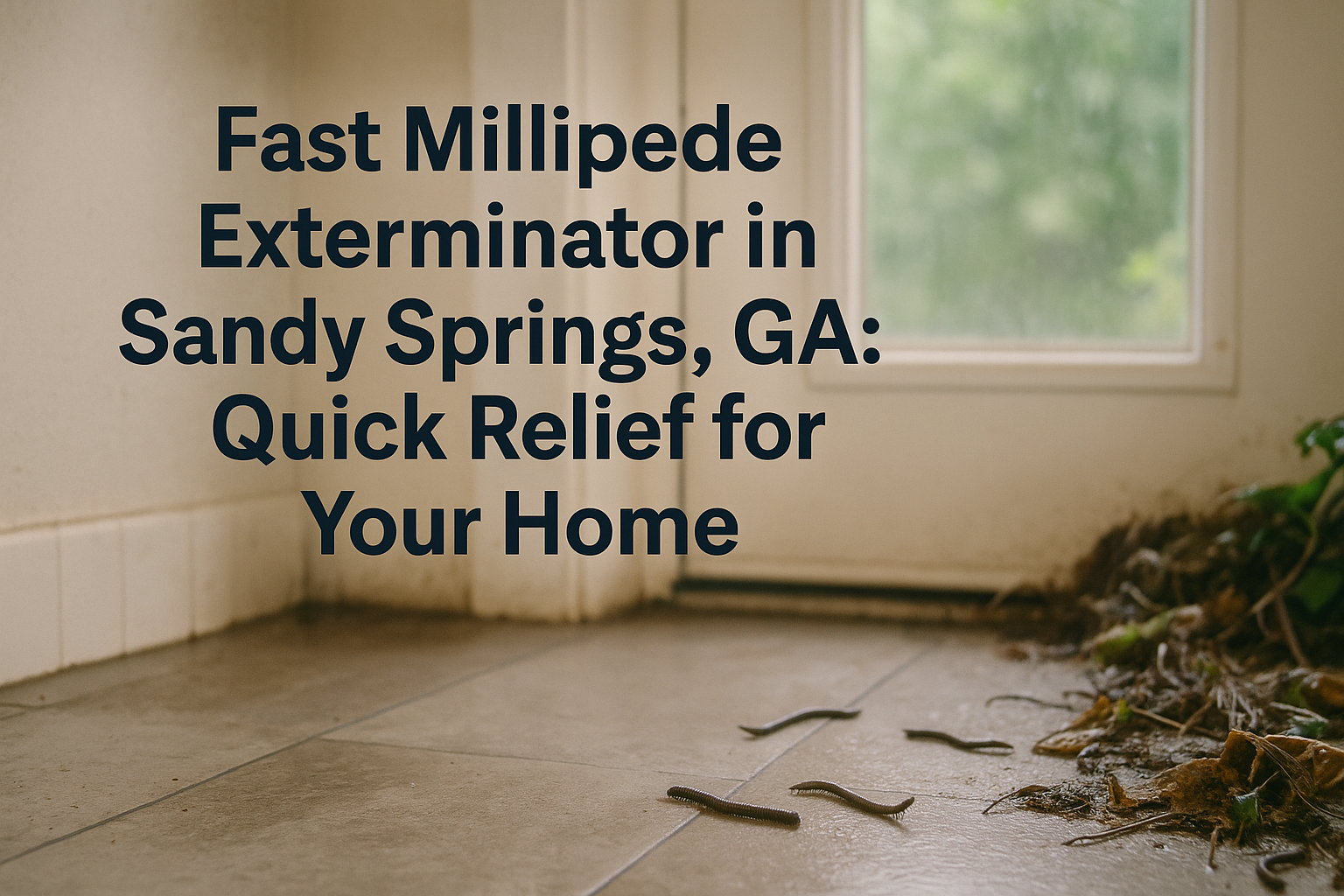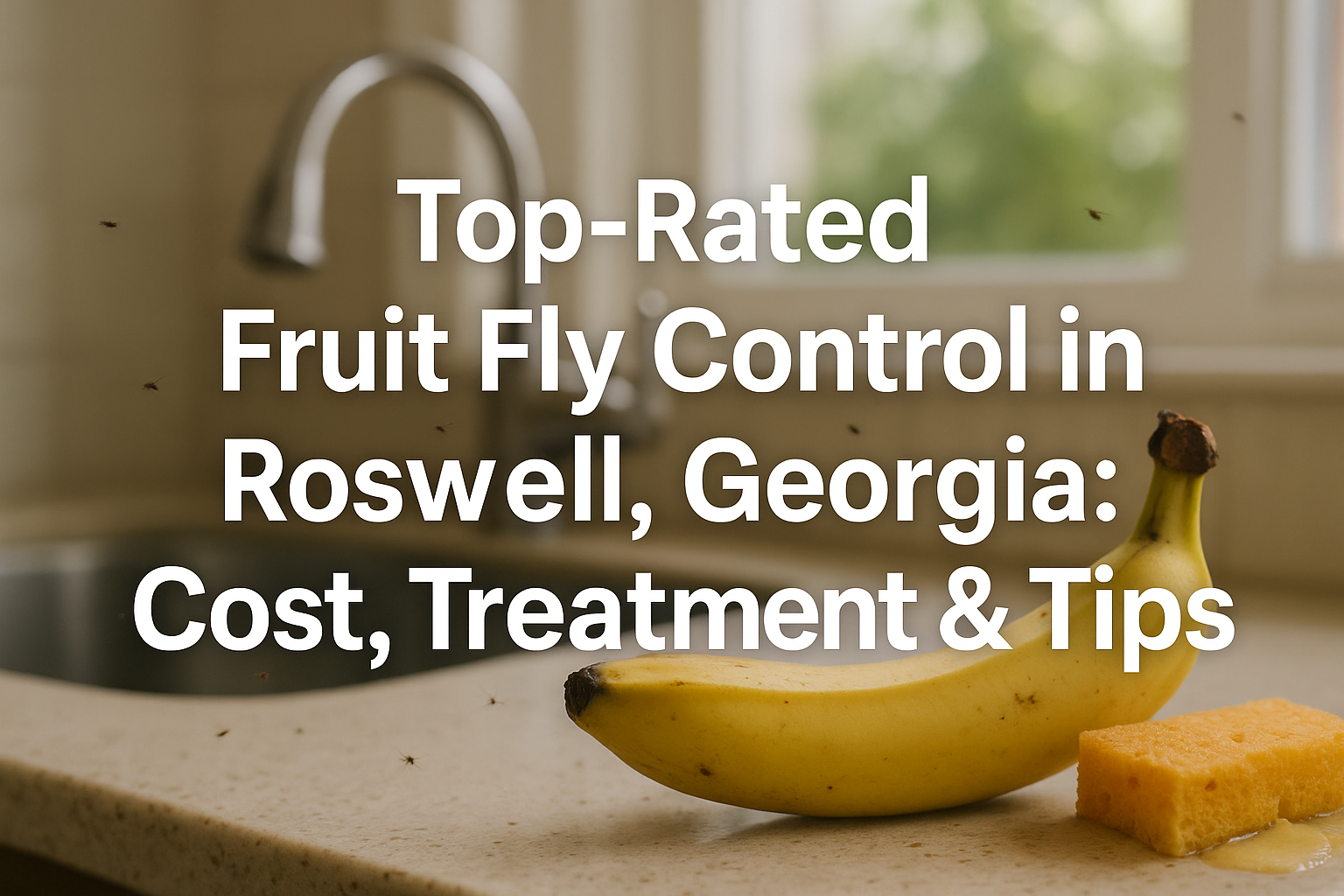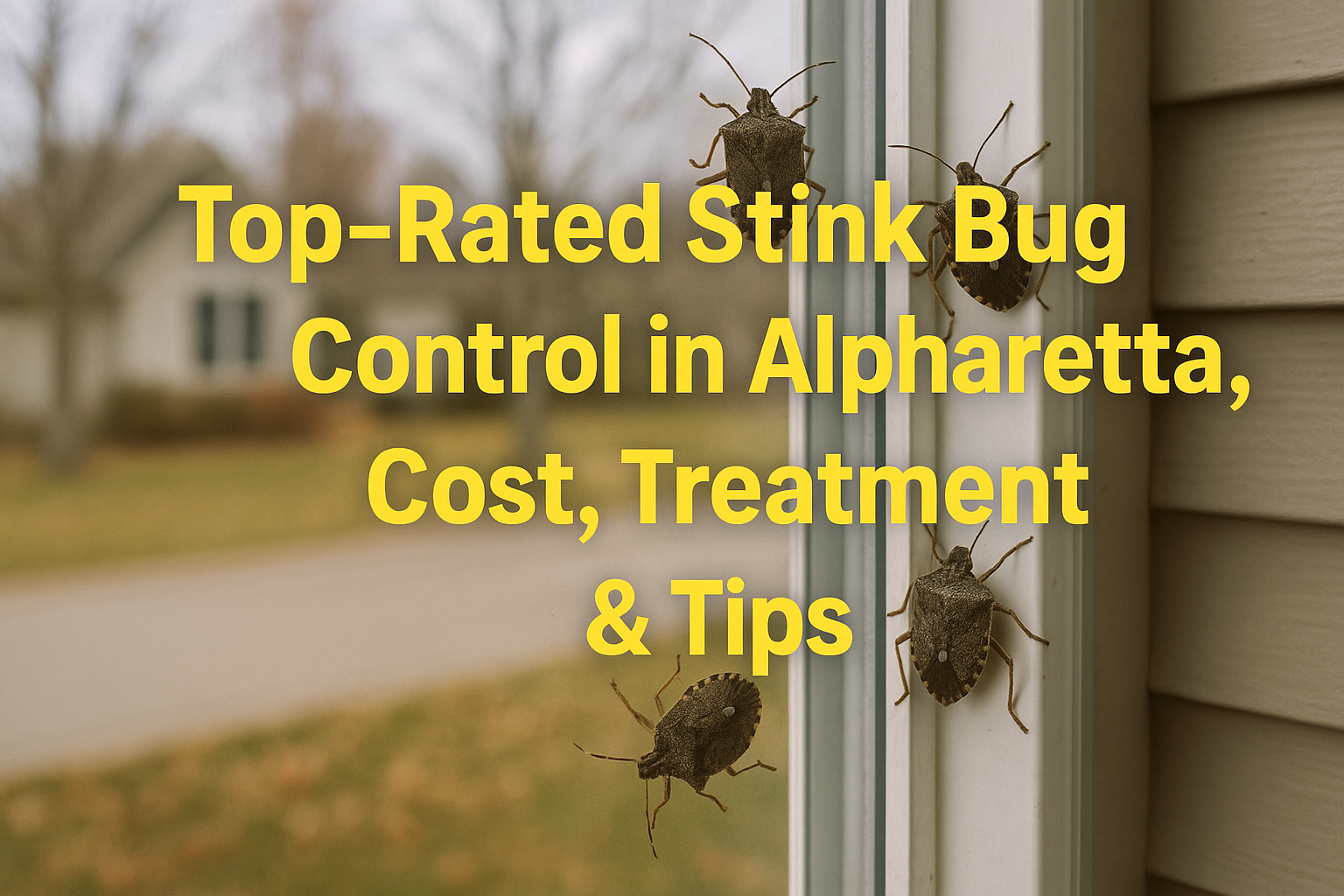Why Millipedes Are Invading Sandy Springs Homes
If you’re spotting those little, twisting black or brown bugs crawling around your basement, bathroom, or even squeezing in by the back door, you’re not alone. Millipede infestations are a real headache here in Sandy Springs, and they seem to know just when to show up—right after it rains, or when the humidity ramps up. Thanks to all the lush trees, shady landscaping, and our famously unpredictable weather, local homes are almost a magnet for these moisture-loving critters. For fast relief, a millipede exterminator Sandy Springs GA homeowners rely on can quickly identify the cause, eliminate infestations, and keep millipedes from returning.
Let’s be honest: seeing millipedes all over your floors isn’t just annoying—it could be a sign that there’s extra dampness or hidden moisture problems sneaking around your property. These bugs love dark, damp hideouts, so when they show up indoors, it’s usually because their natural homes outside have become too soggy or they’ve found the perfect entry point into your crawlspace or basement.
What makes this more frustrating in Sandy Springs is just how common it is. Seasonal rains and thick tree coverage create a perfect storm for millipede populations to thrive, especially close to our homes. And once they make it inside, you’re in for a persistent problem—one that won’t go away without proper attention.
The good news? You don’t have to live with it. Local professional millipede exterminators are quick on the job—most offer same-day appointments right in Sandy Springs. If you’ve already tried the DIY tricks and these critters keep coming back, professional help can put your mind at ease. Treatments typically run between $150 and $275 per visit, depending on the size of your house and just how bad these bugs have gotten. Every home is different, but most folks find that peace of mind is well worth it.
In the next sections, we’ll break down how professional extermination works, what factors influence cost, and share some smart prevention tips to keep millipedes out for good. If you’re ready to get your home back, or just want to make sure these bugs don’t become regular guests, read on for practical solutions that actually work for Sandy Springs’ unique challenges.
What Really Impacts Millipede Extermination Pricing in Sandy Springs?
If you’ve spotted a millipede parade running through your Sandy Springs home, you’re probably wondering: how much is this going to cost me? The answer isn’t one-size-fits-all—it really depends on a handful of key things that can swing your final bill up or down. Before calling a millipede exterminator Sandy Springs GA residents trust, here’s what you need to know about the factors that influence pricing.
- How Big Is Your Property? The larger and more complicated your home or yard, the more labor and materials are needed to kick millipedes out and keep them away. If you have a basement, several stories, or tons of hidden nooks outdoors, expect a bit more work—and a bit more on your invoice.
- Severity of the Problem: Just found a couple crawling around after a rainy night? That’s usually a quick and less pricey fix. But if you’re dealing with a full-blown infestation (think dozens showing up week after week), your pest pro might need extra time, specialty products, or return visits to completely solve the problem.
- The Treatment Method: Professional exterminators almost always get a better result than store-bought sprays. They’ll typically set up a perimeter barrier, go through detailed inspections, and use commercial-grade products that really cut down the population fast. You’ll see a range from $150 to $275 per treatment, but that buys you peace of mind and a comprehensive job—no guesswork. DIY sprays are cheaper, but they rarely keep millipedes out for long.
- Your Neighborhood Factors: If you’re in a newer development with freshly turned soil, or areas near creeks and green zones where it stays humid, you might be at higher risk for millipedes coming inside. Sometimes companies can offer bulk pricing for closely spaced neighbors or add extra moisture-control steps, which can impact your cost either way.
- Type of Service Plan: Are you looking for a quick, one-time rescue, or do you need preventative maintenance so they don’t come back? Ongoing service—like monthly or quarterly treatments—will be priced as a package, sometimes at a discount per visit, but obviously the total can add up over time. These plans are worth it if your home sits in a known trouble spot.
Bottom line: the cost of millipede extermination in Sandy Springs is shaped by the size and type of your home, how bad the infestation has gotten, what method you go with, your location, and whether you just need a quick fix or year-round peace of mind. Getting a local quote is always your best bet—pros will assess your property and walk you through exactly what you need (and what you don’t).
What Really Impacts Millipede Extermination Pricing in Sandy Springs?
If you’ve spotted a millipede parade running through your Sandy Springs home, you’re probably wondering: how much is this going to cost me? The answer isn’t one-size-fits-all—it really depends on a handful of key things that can swing your final bill up or down. Before calling a millipede exterminator Sandy Springs GA homeowners rely on, here’s what you need to know about the main factors that affect extermination pricing.
- How Big Is Your Property? The larger and more complicated your home or yard, the more labor and materials are needed to kick millipedes out and keep them away. If you have a basement, several stories, or tons of hidden nooks outdoors, expect a bit more work—and a bit more on your invoice.
- Severity of the Problem: Just found a couple crawling around after a rainy night? That’s usually a quick and less pricey fix. But if you’re dealing with a full-blown infestation (think dozens showing up week after week), your pest pro might need extra time, specialty products, or return visits to completely solve the problem.
- The Treatment Method: Professional exterminators almost always get a better result than store-bought sprays. They’ll typically set up a perimeter barrier, go through detailed inspections, and use commercial-grade products that really cut down the population fast. You’ll see a range from $150 to $275 per treatment, but that buys you peace of mind and a comprehensive job—no guesswork. DIY sprays are cheaper, but they rarely keep millipedes out for long.
- Your Neighborhood Factors: If you’re in a newer development with freshly turned soil, or areas near creeks and green zones where it stays humid, you might be at higher risk for millipedes coming inside. Sometimes companies can offer bulk pricing for closely spaced neighbors or add extra moisture-control steps, which can impact your cost either way.
- Type of Service Plan: Are you looking for a quick, one-time rescue, or do you need preventative maintenance so they don’t come back? Ongoing service—like monthly or quarterly treatments—will be priced as a package, sometimes at a discount per visit, but obviously the total can add up over time. These plans are worth it if your home sits in a known trouble spot.
Bottom line: the cost of millipede extermination in Sandy Springs is shaped by the size and type of your home, how bad the infestation has gotten, what method you go with, your location, and whether you just need a quick fix or year-round peace of mind. Getting a local quote is always your best bet—pros will assess your property and walk you through exactly what you need (and what you don’t).
Why Millipede Problems Hit Hard in Sandy Springs
Living in Sandy Springs, you probably already know how unpredictable our weather can be—and unfortunately, that keeps pest control pros like us busy, especially when it comes to millipedes. The humid air and those sudden, soaking rains we get every season aren’t just a local talking point. They’re a real headache for anyone trying to keep millipedes outside where they belong.
Picture this: after a heavy downpour, you notice these little critters popping up along your walls or even in the basement. That’s not just bad luck; it’s the combo of our local climate and certain yard features working against you. Here’s what tends to make Sandy Springs homes a magnet for these pests:
- Thick, mature landscapes: All that beautiful, dense foliage and big trees keep soil and mulch beds nice and shady—and moist. Millipedes love that kind of habitat.
- Poor drainage: If your yard slopes toward the house, or your gutters clog up after every storm, water collects right by your foundation. Moisture lingers, giving millipedes plenty of places to hide and breed.
- Older home foundations: If your house has a basement, crawlspace, or weathering bricks, those little cracks and gaps are basically a welcome mat for bugs. Weatherproofing that’s seen better days makes things worse—especially in neighborhoods like Riverside, High Point, and Dunwoody Forest, where lush landscaping and older homes meet.
- Wood siding and bricks: These construction materials can trap extra moisture, especially if there’s mulch or dense ground cover packed tightly against the walls. The result? Millipede central.
- Yard layout: Big beds of pine straw or mulch, plantings right up to the house, even decorative stones—while they look great, they all hold in moisture. And the more moisture, the more likely you’ll see millipedes making a break for your living room when it rains.
It’s not all bad news, though. Knowing what’s unique about Sandy Springs homes helps a pro build a plan that actually works. Think of it this way: if an exterminator spots a drainage problem or aging sealant around a crawlspace, they can tackle the root cause, not just the symptoms. And that means you’re likely to need fewer treatments, saving you headaches and money in the long run.
Bottom line, every home here has its quirks—yours included. Paying attention to these local details is the key to getting millipede problems under control for good.
Stay Ahead of Millipedes with Smart Prevention
If you want to keep millipedes out of your Sandy Springs home—and keep exterminator costs low—it pays to focus on prevention. A few simple habits can make all the difference. Start by walking the outside of your house and checking for cracks or gaps in the foundation. Even tiny entry points are an open door to pests, so fill and seal them up right away. Check your weatherstripping around doors and windows, and replace anything that’s seen better days—millipedes can squeeze through those little gaps too.
Moisture is a millipede’s best friend. Check your gutters and downspouts: are they moving water away from your foundation, or causing damp spots near the house? Adjust them if you notice runoff pooling around the base. The same goes for the slope of your yard—proper grading sweeps water away instead of letting it collect near your walls. And when it comes to landscaping, don’t pile mulch or leaves up against the house. Keep at least a foot or two clear to eliminate hiding spots.
Inside, a dry environment is key. Basements, crawl spaces, and laundry rooms all love to hold onto humidity, and so do millipedes. A dehumidifier in these areas can be a game changer, especially when the weather gets muggy.
- Seal all visible cracks and gaps around your home.
- Replace worn weatherstripping on doors and windows.
- Make sure gutters and downspouts steer water away from the foundation.
- Keep mulch and leaf piles away from exterior walls.
- Run dehumidifiers in damp indoor areas, especially basements.
Put yourself on a regular inspection schedule—do a quick walkaround every season or after big storms. Spotting small issues early prevents big pest bills down the road. Many Sandy Springs homeowners, especially in areas like Hammond Hills and Chastain Park, find peace of mind through annual pest control plans. These catch problems before they get expensive and help you feel comfortable year-round, not just in millipede season.
Preventive steps now mean fewer pests—and fewer surprises—for your home and your wallet. Check out the next visual to build your own seasonal home protection plan.
When to Tackle Millipede Problems in Sandy Springs
If you’ve ever seen millipedes invading your home right after a heavy downpour, you know timing is everything. In Sandy Springs, millipedes really start showing up in the spring and again after those pop-up summer thunderstorms—because nothing sends them searching for dry ground faster than soggy Georgia soil. Knowing when to get ahead of these little invaders is a real game-changer for both your wallet and your peace of mind.
- Spring & Summer Rains: That’s when millipede calls spike, and honestly, it’s when we get booked solid. Prices can rise a bit, and getting your top-choice appointment slot gets tough.
- Early Spring or Late Fall: Want the best deal and flexible scheduling? These are your moments. Less demand means you can often lock in a better rate and get a technician out before the rush.
- Neighborhood Savvy: Folks in Glenridge and Mountaire Park know the drill—booking early means unbeatable protection and no scramble when it rains. If you get ahead of the crowd, you’re also less likely to need emergency visits (and those aren’t cheap).
Proactive prevention is pure strategy—putting down treatments just before rain season makes your barrier last longer and helps shut down infestations before they start. Reactive treatments, on the other hand, are more of a band-aid and can mean recurring costs if the bugs are already inside. Bottom line: in Sandy Springs, timing your pest control efforts with the help of a millipede exterminator Sandy Springs GA residents trust not only benefits your budget but also gives you longer-lasting, more satisfying results.
Let’s Get Millipedes Out of Your Sandy Springs Home—For Good
If you’re tired of spotting millipedes crawling where they don’t belong, it’s time to call in the local experts who truly care. At Anthem Pest Control, we make it easy—just give us a call at 877-3718-5196 or request your free, no-obligation inspection online. We’ll check out your property, explain exactly what’s going on, and lay out clear, upfront pricing. No pressure, no surprises—just honest answers and results you can trust. You deserve a millipede-free home, and we’re here to make it happen quickly and affordably. Your comfort comes first with Anthem – let’s get your problem solved today!
Frequently Asked Questions About Millipede Control in Sandy Springs
- Are millipedes dangerous to my family or pets?
No need to worry—millipedes in Sandy Springs aren’t dangerous. They don’t bite, sting, or spread disease. The main complaint is the stink they give off when crushed and the overwhelming numbers that sometimes parade through homes. - What signs should I watch for?
If you notice clusters of millipedes in bathrooms, laundry rooms, or near doors—especially right after a rain—there’s a good chance you’ve got an invasion in progress. Their favorite spots are the damp, darker corners you probably don’t check every day. - Can I get rid of them myself?
For a couple here and there, a basic home spray might work fine. But if you’re dealing with more than a handful—or they keep coming back—it’s smart to call in a pro. Experts have the tools and know-how to tackle big infestations and keep millipedes out for good. - How quickly can a pro respond in Sandy Springs?
Good news: many local pest control companies offer same-day or next-day appointments, especially during peak season. If you call in the morning, you might be breathing easier by the afternoon. - Is treatment safe for my kids and pets?
Professional companies in Sandy Springs use eco-friendly, regulated products that are safe for families and animals, provided everything is applied by a licensed tech. You’ll usually get clear instructions about when it’s okay to re-enter treated rooms or yards. - What does it cost to get rid of millipedes in Sandy Springs?
Typical prices range from $150 to $275 for standard treatment, but costs can go up if you have a big property, severe infestation, or want preventative treatments. It never hurts to get a quote based on your specific situation. - Which neighborhoods have the most millipedes?
If you’re in Riverside, High Point, or Dunwoody Forest, you’re smack in the zone: mature trees and frequent rain mean millipedes love it there. But honestly, if your yard is shady and stays damp, you’re a target. - How do I keep millipedes from coming back?
Your best bet is to take away what draws them in—manage indoor and outdoor moisture, seal up little cracks and gaps around doors or windows, and schedule regular exterior treatments. A little attention now keeps the swarms away later.












